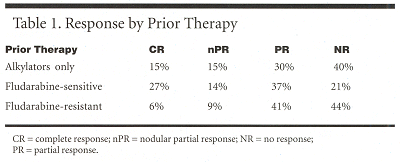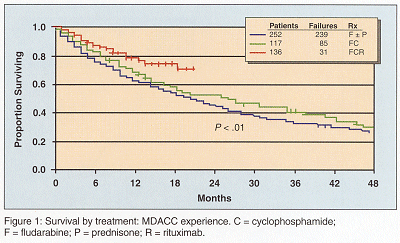Rituximab Adds Survival Advantage to Fludarabine/Cyclophosphamide for CLL
HOUSTON-Adding rituximab (Rituxan) to fludarabine (Fludara)/cyclophosphamide (Cytoxan, Neosar) (FCR) prolongs survival in patients with relapsed chronic lymphocytic leukemia (CLL), according to Guillermo Garcia-Manero, MD. Dr. Garcia-Manero is assistant professor in the Department of Leukemia at The University of Texas M. D. Anderson Cancer Center in Houston. He presented updated data on this study in a poster at the 43rd Annual Meeting of the American Society of Hematology.
HOUSTONAdding rituximab (Rituxan) to fludarabine (Fludara)/cyclophosphamide (Cytoxan, Neosar) (FCR) prolongs survival in patients with relapsed chronic lymphocytic leukemia (CLL), according to Guillermo Garcia-Manero, MD. Dr. Garcia-Manero is assistant professor in the Department of Leukemia at The University of Texas M. D. Anderson Cancer Center in Houston. He presented updated data on this study in a poster at the 43rd Annual Meeting of the American Society of Hematology.
During course 1, rituximab was given at a slow rate at 375 mg/m² on day 1 followed by fludarabine at 25 mg/m² and cyclophosphamide at 250 mg/m² on days 2-4. During subsequent courses (2-6), rituximab was given at 500 mg/m² on day 1 and fludarabine and cyclophosphamide, which were given at the same doses, were given on days 1-3.
Data on Previously Treated CLL Patients
Dr. Garcia-Manero presented data on 136 patients with previously treated CLL. These included 4 with Rai stage 0, 35 with stage I, 26 with stage II, 19 with stage III, and 52 with stage IV disease. Patients had a median of 2.5 previous treatments (range: 1-10). Median platelet count at baseline was 116.5 × 109/L (range: 6-388 × 109/L); median hemoglobin was 12.1 g/dL (range: 6.8-16.5 g/dL); and median white blood count was 51.9 × 109/L (range: 1.3-583 × 109/L). Sixty percent of patients had three or more lymph node sites involved.
Using National Cancer Institute (NCI) criteria, Dr. Garcia-Manero reported 28 (21%) complete responses (CR), 18 (13%) nodular partial responses (nPR), and 50 (37%) partial responses (PR), for an overall response rate (ORR) of 71%. Five of 14 patients (35%) who had immunoglobulin rearrangements detectable by polymerase chain reaction (PCR) assay at study entry had molecular complete responses (PCR negative) after treatment. Responses varied depending on prior therapy (see Table 1).

Rituximab Combination Prolongs Survival
Compared to historical data on CLL patients treated with fludarabine/cyclophosphamide, the FCR combination prolonged survival (see Figure 1). Adding rituximab increased not only the ORR but the proportion of those responses that were complete remissions, according to Dr. Garcia-Manero.

Frequent toxicities related to rituximab included chills and fever. Others were nausea/vomiting, hypotension, and dyspnea. Serious toxicities included eight episodes of pneumonia, seven episodes of neutropenic fever, five of sepsis, and one prolonged myelosuppression.
"In summary, the combination of fludarabine, cyclophosphamide, and rituximab is a very active program for patients with previously treated CLL," Dr. Garcia-Manero said.
Newsletter
Stay up to date on recent advances in the multidisciplinary approach to cancer.
Elevating the Quality of Cancer Care via Cross-Department Collaboration
Experts from Sibley Memorial Hospital discuss how multidisciplinary work has enhanced outcomes such as survival and resource use at their institution.